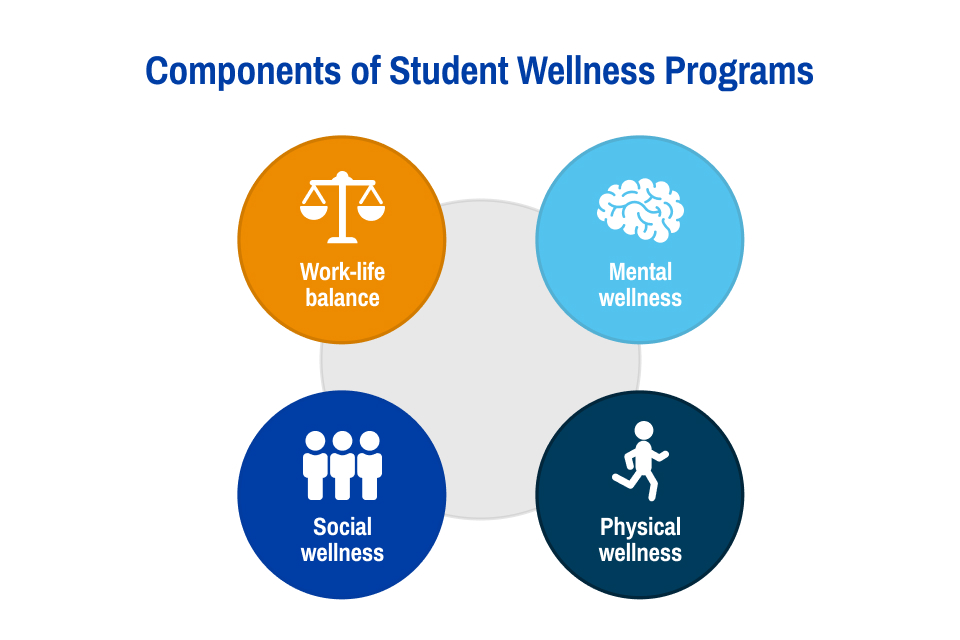Prioritizing Student Wellness in Medical and Graduate Biomedical Education
Students who are enrolled in demanding medical and graduate biomedical education programs can experience mental health concerns including burnout and stress. Left unaddressed, these concerns can lead to poor grades, reduced research output, and even withdrawal from training.
There has been a promising trend among medical and graduate biomedical education programs to incorporate student wellness into curricula, which can lead to better student outcomes both during and after training. This blog post explores why wellness should be a core component of these programs, outline elements of effective wellness initiatives, and offer strategies to help build a culture that prioritizes student well-being.
Identifying the Need for Wellness Programs
Medical and graduate biomedical training programs are intense, competitive, and often all-consuming. Students routinely face long hours of study, research, and clinical obligations—coupled with the constant pressure to perform at a high level. This environment contributes to high rates of stress, burnout, and mental health concerns.
Many medical schools have started to recognize that incorporating student wellness into curricula is a necessity. Programs that prioritize student wellness can see improvements in academic performance, reductions in anxiety and stress, and decreases in attrition resulting from enhanced peer and social programming. Incorporating wellness into graduate and medical programs can take significant coordination and requires commitment at all levels of leadership, but even seemingly small initiatives can have positive implications for overall professional development and long-term success of students.
Student Wellness Program Components
Wellness programs can take many forms, and institutions should provide opportunities to students to address the various aspects of wellness. Many resources, such as mental health counseling and access to student facilities, may already be in place but may be underutilized, while other types of support might need to be developed specifically for this population. There are four basic levels of support for student wellness to consider:
Mental wellness: Counseling and support groups can help students deal with the challenges of rigorous training programs; however students often are not aware of these resources or are hesitant to utilize them. Institutions that normalize mental health care early on, streamline the process for accessing counseling, or provide dedicated counselors to serve their student population report higher utilization of these programs. When students are introduced to resources and encouraged to use them early on, before urgent need arises, receiving mental health care may be more likely to be seen as a customary component of training.
Physical wellness: Supporting physical needs is another important component of wellness programs. Many institutions already have fitness centers and healthy dining options, but knowledge of and participation in these resources may be low priority for students who face heavy workloads. Program directors can encourage students to address their physical wellness by providing convenient options such as close-proximity facilities and by introducing the importance of physical wellness during orientation programs. Some institutions have found success in providing their graduate students with mentorship programs aimed at helping develop and maintain healthy habits, while other programs provide free-of-charge nutrition counseling to students to support their physical wellbeing.
Social wellness: Building a supportive student community is another pillar of a comprehensive wellness program. Graduate and medical training can feel isolating. Institutions can foster a sense of belonging by supporting student organizations and clubs. Encouraging participation in community-building activities such as retreats, volunteer opportunities, or social events can strengthen peer networks and reduce feelings of isolation.
Work-life balance: Maintaining a balance between academic obligations and personal life is essential, yet it can be overlooked in demanding training programs. Oversight of student workloads and proactive scheduling can help prevent burnout before it begins. Institutions can build in time for rest, self-care, and wellness activities by offering flexibility in the academic calendar. Promoting healthy boundaries and supporting students in prioritizing non-academic aspects of life are key to fostering longevity and satisfaction in their careers.

Strategies for Integrating Wellness
Successfully incorporating wellness into medical and graduate biomedical education requires a multi-faceted approach that targets several key areas of the academic environment. When institutions commit to wellness for their medical and graduate biomedical students, they should prioritize curricular changes and faculty training. These key areas can work in synergy in support of an institutional culture of wellness:
Curricula: Embedding wellness directly into the curriculum sends a strong message that well-being is a priority. Programs such as the NIH’s Becoming a Resilient Scientist series and the AAMC’s Medical Student Resilience Curriculum are examples of structured, evidence-based resources that can be integrated into existing coursework. Programs should also consider intentionally scheduling time for wellness-related activities to reinforce the idea that self-care is a vital component of professional development.
Faculty engagement: Faculty play a critical role in shaping program culture, and their support is essential. Institutions can foster buy-in by communicating the value of wellness efforts and providing training to help faculty recognize signs of burnout or distress in students. Faculty who model healthy habits and engage in wellness programming themselves can help shift the cultural norm, making it easier for students to prioritize their own well-being. Additionally, encouraging faculty to actively promote wellness resources in their classrooms and labs can improve utilization and reduce stigma.
Institutional support: For wellness efforts to be sustainable and impactful, they should be backed by institutional commitment. This includes not only monetary investment—such as funding for dedicated wellness staff or facilities—but also temporal investment in the form of protected time for wellness activities. Institutions that allocate resources to wellness programming demonstrate a tangible commitment to student success and create an environment where well-being is not just encouraged, but expected.
Conclusion
Student wellness has become a necessity for the success and sustainability of medical and graduate biomedical education. By incorporating wellness into the curriculum, engaging faculty, and securing institutional support, programs can create a culture in which students can excel academically and thrive personally and professionally. Many institutions have implemented successful wellness programs, with measurable improvements in student mental health, academic performance, and retention rates. When wellness is prioritized as part of the academic mission, students are empowered to develop the resilience that will support their future careers as scientists, clinicians, and leaders in healthcare.
 Colleen Bocke is a doctoral candidate in the department of Pharmacology and Physiology
at the Saint Louis University School of Medicine. Bocke’s areas of professional interest
include student wellness, biomedical science curriculum development, and physiology
education. Bocke can be found on Linkedin or contacted via email.
Colleen Bocke is a doctoral candidate in the department of Pharmacology and Physiology
at the Saint Louis University School of Medicine. Bocke’s areas of professional interest
include student wellness, biomedical science curriculum development, and physiology
education. Bocke can be found on Linkedin or contacted via email.